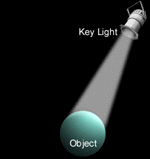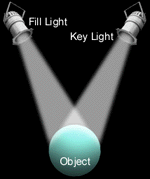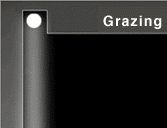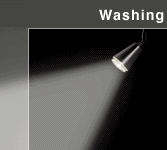Lighting Design: Basic Strategies
Light plays an essential role in our ability to perceive the world around us; the lighting system plays a critical role in how we perceive a space and can even influence how we act in that space. Lighting can affect performance, mood, morale, safety, security and decisions.
The first step in producing the right lighting design is to ask what the space is used for. The lighting designer can then determine quantity of light, color quality, brightness and direction.
It is beyond the scope of this article to go step by step through the process of producing a lighting design. Instead, we will review the several ways that lighting professionals look at lighting design, from the simple to the sophisticated.
Simple. One way is to ensure that the lighting system 1) provides ambient illumination for orientation and general tasks in the space, 2) task illumination for local, more demanding tasks, and 3) accent illumination to highlight special objects of interest or to guide occupants. An example of this scheme is an open office plan with workstations; we might provide indirect fixtures to provide ambient illumination, task lighting at the workstations for work, and accent lighting to highlight pieces of corporate art on the walls.
Standard. A typical general approach to lighting design is, after determining how the space is used, to provide general, localized general, localized and task illumination to meet these needs. General lighting provides a generally uniform light level on the workplane throughout the lighted space. Localized general lighting is similar but is tailored more to the location of tasks in the lighted space. Localized lighting, also called supplemental lighting, is used to provide light to a specific area. Task lighting delivers light tailored for a specific task.
Sophisticated. A final way of looking at lighting design is more sophisticated, focused not only on simply providing quantity of footcandles for tasks with accent illumination for highlighting, but also on the art of using light to produce a desired effect.
To explain this last approach, which deals with how the direction of light is controlled, let us start with an object.
 Key Light
Key Light
When we shine a light on an object from a single point source of light it is called key light; it highlights contours on the object and creates shadows; the exact effect depends on the angle of the beam of light. Most of the time we want to light the object to we can see its front. In these cases, the light source may be best place in front of and to the side of the object at an angle of 45°.
 Fill Light
Fill Light
While this scene effects drama, for our purposes we will assume we need fill light. It can either be directional or diffused. In our example we could shine a directional light on the object from the opposite direction of the key light, softening or eliminating shadows depending on the strength of the fill light relative to the strength of the key light. We could also place fill light sources behind the object to light the entire room evenly. In the Figure below, we see the keylight supplemented by a single fill light.
 Silhouetting
Silhouetting
Suppose we wanted to emphasize the shape of the object as a silhouette. In this event, we would soften or even eliminate the key light and directional fill light, and instead provide only fill light, either intense or diffused, depending on the clarity of the silhouette and the drama we want to produce.
Uplighting
Suppose we wanted to uplight the object. The effect of uplighting is either very desirable or very undesirable because it is unusual. Effects range from intimate to eerie. A lot of landscape lighting includes uplighting to accentuate bushes and trees.
Sparkle and Glitter Effects
To add an atmosphere of elegance, we could add little lighting points of interest in the form of sparkle or glitter. This effect can be produced by either producing sharp reflections on specular surfaces in the room (sparkle), such as silverware in a restaurant, or by making the light source itself a source of interest (glitter) such as with a chandelier. Beware of glare in such cases.

 Grazing and Washing Surfaces
Grazing and Washing Surfaces
On walls or on the surface of an object, we can change the way light impacts them so that we can produce different effects. Suppose we have a brick wall with a rough texture that we want to emphasize. We could graze the surface with light, meaning the light would strike the surface at a sharp angle. In this case, the light source would be mounted close to the wall. Now suppose the wall is smoother, and we want to emphasize that smoothness. We could wash the surface with light, meaning the light would strike the surface at a wider angle.
The selection of strategy or combination of strategies again will depend on how the space is used. In a retail environment, it might be desirable to provide strong keylighting to accentuate and dramatize key merchandise, while in an office such strong concentrations of accentlighting and shadowing might prove visually fatiguing. Uplighting may work well in an intimate restaurant or to highlight bottles of alcohol in a bar, but may make people look sinister in the home or office. Sparkle and glitter may work well in a restaurant, but might prove distracting in many industrial work areas.
Additional References:
Lighting Design Lab offers publications on a variety of lighting topics that include design, controls, color temperature and technology.

